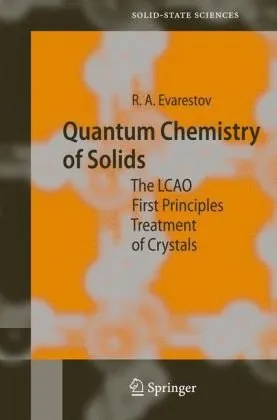Quantum Chemistry of Solids: The LCAO First Principles Treatment of Crystals (Springer Series in Solid-State Sciences)
4.9
Reviews from our users

You Can Ask your questions from this book's AI after Login
Each download or ask from book AI costs 2 points. To earn more free points, please visit the Points Guide Page and complete some valuable actions.Introduction
Welcome to 'Quantum Chemistry of Solids: The LCAO First Principles Treatment of Crystals,' a comprehensive guide designed to bridge the gap between solid-state physics and quantum chemistry. Authored by Robert A. Evarestov, this book is an integral part of the Springer Series in Solid-State Sciences and caters to both theoretical insights and practical applications in the study of crystals.
Detailed Summary of the Book
This book delves into the quantum chemical methods for solid-state calculations, focusing on the Linear Combination of Atomic Orbitals (LCAO) methodology. Through a systematic exploration, the text visits the underlying physics and mathematics, presenting the foundational principles required to understand the electronic structure of solids. From basic concepts of crystallography to complex electronic interactions, Evarestov carefully develops the subject matter to furnish readers with a well-rounded understanding of quantum chemistry as applied to solid materials.
Evarestov's narrative takes you through the theoretical frameworks, bolstered by advanced computational strategies used in modern solid-state research. By integrating classical approaches with contemporary computational techniques, the book offers its readers the knowledge required to solve real-world problems in materials science. The text is crafted to be accessible to professional practitioners as well as graduate students, ensuring that evolving complexities of the field are comprehensible through numerous examples and problem sets.
Key Takeaways
- Comprehensive understanding of the LCAO method in solid-state chemistry and physics.
- Insightful exploration of the electronic structures and properties of crystals.
- Extensive treatment of computational methods for electronic structure modeling.
- Connections between theoretical principles and practical applications in materials science.
- Numerous examples and exercises to bolster understanding and encourage practical skill development.
Famous Quotes from the Book
Understanding the quantum nature of materials allows us to not just view them as static entities, but as dynamic systems full of potential and intricate behaviors.
The LCAO methodology serves as a bridge, linking the critical abstract theories of quantum chemistry to the tangible and observable phenomena seen in the realm of solid-state physics.
Why This Book Matters
In an era where materials science is pivotal to technological advancement, 'Quantum Chemistry of Solids' stands as a crucial resource for understanding the quantum mechanical underpinnings of solid-state matter. As innovations in electronics, energy storage, and information technology continue to emerge, a deep knowledge of materials at the quantum level becomes imperative for researchers and engineers. Evarestov's work is not merely an academic exercise; it is a formidable tool that empowers its readers to partake in groundbreaking research and development.
Moreover, the book's commitment to an LCAO perspective offers a unique vantage point for academics and professionals. By navigating the confluence of theoretical and practical insights, Evarestov provides a robust framework that is both adaptable and forward-looking, making this book a timeless addition to the academic and professional libraries of anyone engaged in the study or application of quantum chemistry and solid-state sciences.
Free Direct Download
You Can Download this book after Login
Accessing books through legal platforms and public libraries not only supports the rights of authors and publishers but also contributes to the sustainability of reading culture. Before downloading, please take a moment to consider these options.
Find this book on other platforms:
WorldCat helps you find books in libraries worldwide.
See ratings, reviews, and discussions on Goodreads.
Find and buy rare or used books on AbeBooks.
1153
بازدید4.9
امتیاز50
نظر98%
رضایتReviews:
4.9
Based on 0 users review
"کیفیت چاپ عالی بود، خیلی راضیام"
Questions & Answers
Ask questions about this book or help others by answering
No questions yet. Be the first to ask!


